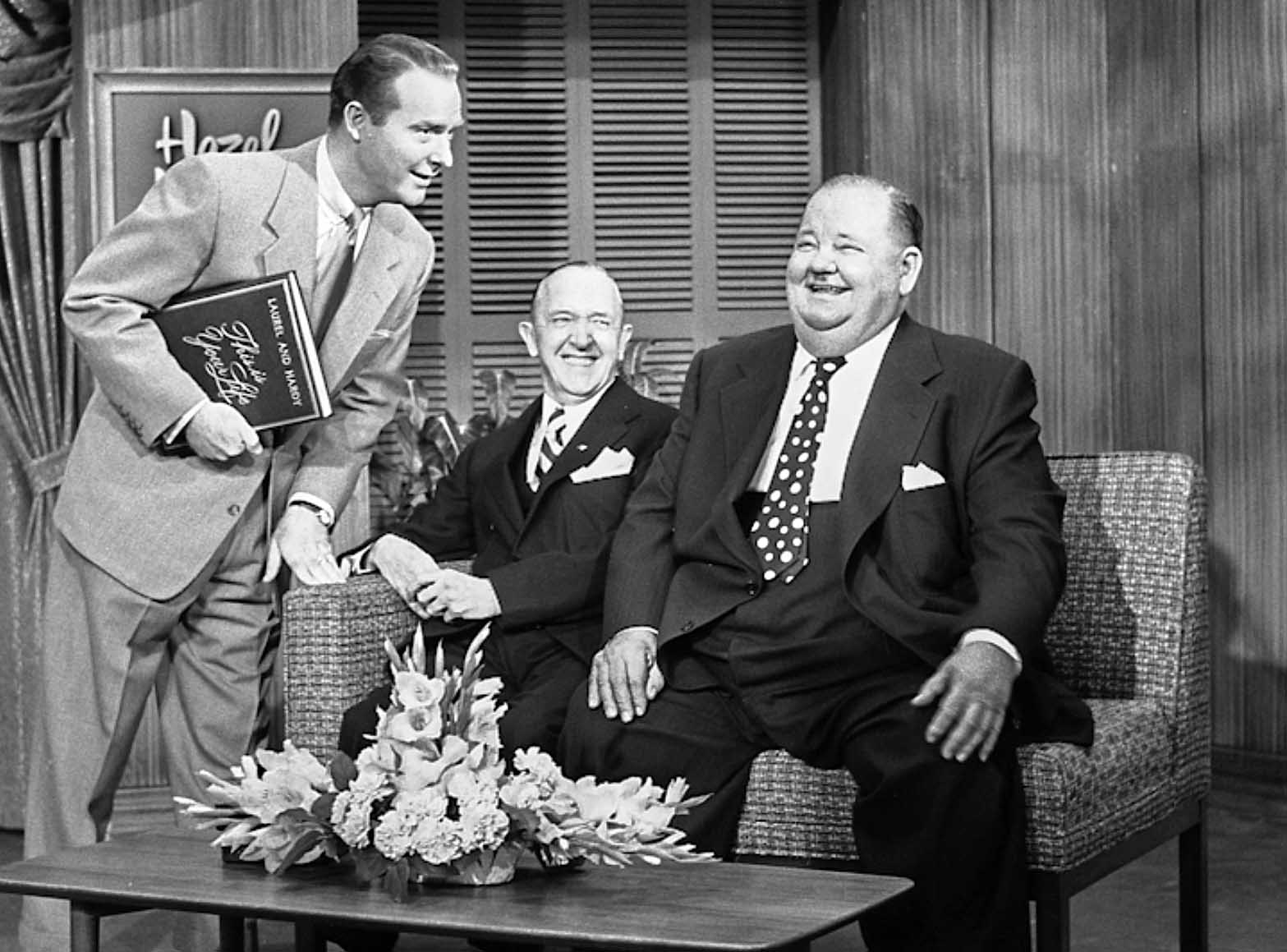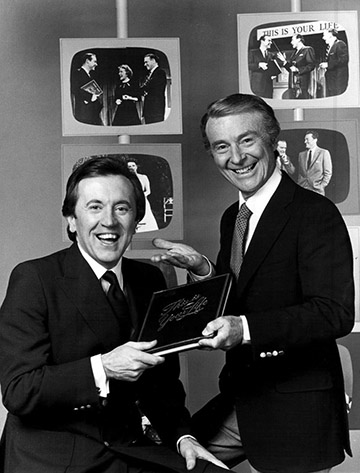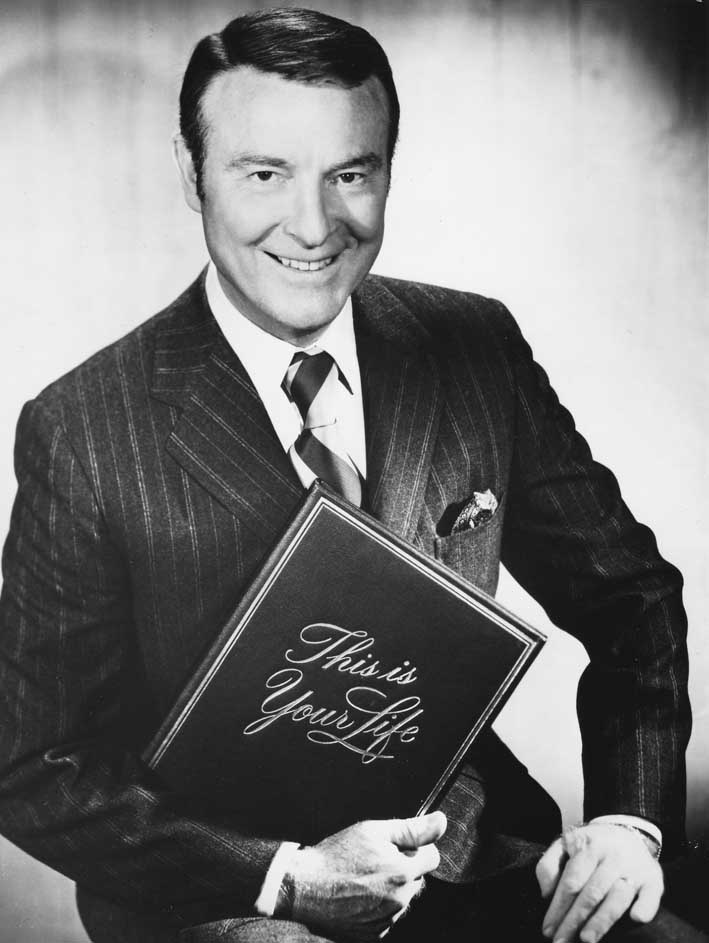Big Red Book
Celebrating television's This Is Your Life
Ralph Edwards (1913-2005)

"It sort of evolved from our wartime bond sales and the other things we had been doing for the servicemen..."
This Is Your Life developed out of a small section on a hugely successful American radio audience participation show called Truth or Consequences, created by a young radio announcer and producer named Ralph Edwards.
Almost by accident Ralph Edwards created a whole new entertainment format...
related pages...
a brief biography
tributes to the original presenter
the programme's icon
the producers who steered the programme's success
the show's fifty year history
the genesis of the programme
first-hand recollections
The Origin of This Is Your Life
A comprehensive account of how it all started
Radio Times previews the first edition
The Manchester Guardian reviews the first edition
Radio Times previews the second edition
This Is Your Life: The Show that can never be fully rehearsed
TV Mirror goes behind-the-scenes of the first series
John Bull Magazine interviews Eamonn Andrews
Interview with the first producer of This Is Your Life
The return of This Is Your Life
The Stage previews the new series
This Is Your Life's creator dies
BBC report on the death of Ralph Edwards
Ralph Edwards, who was born on 13 June 1913, grew up on his family's farm near Merino, Colorado, before moving to California with his family when he was 12.
While performing with his school drama club, he was seen by a radio producer who offered him some work at the local radio station.
Ralph later recalled:
"...I worked at some little local stations, also at KFRC, which was the CBS affiliate in San Francisco... I think that the many areas that I covered in radio, announcing, writing, producing and acting, along with my theatrical training at University of California, prepared me for the breaks when they came my way."
Having graduated from the University of California in 1935, Ralph moved to New York the following year, where, with the radio experience he had gained while studying, he had no difficulty finding work. In fact, by the time he was 25, he had become the number one announcer on CBS and NBC – working on more than 40 shows a week.

Ralph Edwards was the number one announcer on CBS and NBC radio by the time he was 25 years old
Ralph quickly established himself as a nationally famous announcer, but as he said later:
"I was looking for that one big night-time show of my own..."
Using the basis of a childhood game he and his friends would play on the farm in Colorado, he created what would become a landmark audience participation show - Truth or Consequences.
Following a successful pilot, Truth or Consequences premiered on NBC Radio in March 1940 and became an immediate hit, rapidly establishing itself as US radio's number-one audience participation show.
As host, Ralph would ask contestants a humorous trivia question that was usually impossible to answer correctly, resulting in the contestant facing the 'consequences' by performing a zany and often embarrassing stunt.

Truth or Consequences premiered on NBC Radio in March 1940
Originally broadcast from New York before moving to Los Angeles, the show is credited with several entertainment 'firsts': It was the first to leave the studio and broadcast on location, the first to stage surprise reunions, and the first to combine entertainment with a cause. These innovations became the springboard for later programmes and would influence many future game and reality shows.
Ralph quickly realised radio's potential to support good causes during the Second World War. Many of the acts that appeared on the show had a tie-in to the war effort. So, in an unprecedented series of War Bond tours, Ralph took Truth or Consequences on the road, covering 100,000 miles to raise half a billion dollars in bonds. This achievement was rewarded with a special General Eisenhower Award.
Shortly after the war, General Omar Bradley, who was in charge of the Veterans' Administration, told Ralph he had been impressed by his fundraising efforts and asked him if there was something he and his team could do to help the disabled veterans.
Ralph later recalled:
"They told me wounded, paraplegic boys were often afraid to go home, fearful they wouldn't be accepted and properly cared for. I decided to devote a segment of Truth or Consequences to wounded servicemen, reuniting them with friends and getting them to talk about their past.
We came up with the idea to present an ex-marine called Lawrence Tranter, who was confined to a wheelchair from his war wounds... and surprise him with a show of love from all his family and friends."
And so, on the 27 April 1946 edition of Truth or Consequences, Lawrence Tranter appeared as a contestant; his consequence was to relive his past. Ralph presented his 'life', with friends and family entering one by one as the narrative unfolded.
Ralph then invited Tranter to attend the Bulova School of Watchmaking, which had recently been established to teach a craft to disabled veterans. Tranter returned to Truth or Consequences two years later for the presentation of his diploma, and all that went with it, including a fully stocked store and a year's paid rent.
On that particular show, Ralph Edwards first spoke the words 'This is your life'.
Fan mail poured in following the broadcast, and Ralph realised he had created a whole new entertainment format:
"As all this unfolded, I realised we had a great new show, and This Is Your Life began on radio in 1948."
This Is Your Life debuted live on NBC Radio on 9 November 1948. During its first two radio seasons, Ralph surprised an incredible cross-section of the American people – from a 19-year-old Ice Follies skater to a 100-year-old veteran of the Civil War.
After the success of the radio version, This Is Your Life was developed for television and following a pilot in May 1951 as part of Truth or Consequences – which had also moved from radio to television – the programme's first season was launched on 1 October 1952 on NBC Television, and quickly became an icon of popular culture.

This Is Your Life quickly established itself as required viewing after the first season began in October 1952 on NBC Television
The format of the programme grew out of the Truth or Consequences edition that featured Lawrence Trantor, as each week Ralph would surprise an unsuspecting person (usually a celebrity or sometimes an ordinary citizen) and review their personal and professional life in front of the TV audience, with the help of figures from their past, who would share a story or anecdote.
The programme had great appeal for viewers, mainly because of the surprise element of the show, as the identity of that week's subject was never revealed before the broadcast.
Ralph later commented on the secrecy aspect of the show:
"Actually, it wasn't as hard as you might think. People love surprise parties, and so the friends and relatives were usually very good at keeping their mouths shut! Even the press was unusually cooperative. It's amazing how rarely the secret got out – only 4 times, I think we had to cancel."
Throughout the half-hour, Ralph would guide the show's narrative, ushering guests on and off stage and eventually prompting the subject to recall a personal turning point.
Ralph often emphasised the sentimental side of a subject's story - another aspect of the show that appealed to viewers - as his on-air tributes often recounted some heroic sacrifice or tragic event, bringing the audience (and sometimes the subject) to tears.
Eamonn Andrews later noted that Ralph was "a calculating go-getter with a flair for seeing the drama and emotion in people's lives."
Much like Truth or Consequences, Ralph used This Is Your Life to promote worthy causes. Ralph's audiences gave generously to numerous worthy causes, such as providing the first donations for the USS Arizona Memorial in Pearl Harbor as well as helping to endow schools and build hospitals.
Notable editions from this early run of This Is Your Life include one of the first televised accounts of a Holocaust survivor and the only live US television appearance of the legendary film comedy team Laurel and Hardy.

Holocaust survivor Hanna Bloch Kohner was featured in May 1953

Legendary film comedy duo Laurel and Hardy were surprised in January 1954
Ralph later explained how subjects were chosen:
"We got ideas from all over the place, staff, of course, but also friends; viewers would write in with suggestions; news stories – just about everybody has a life story that deserves to be told."
Other editions addressed alcoholism and mental illness when those topics were still considered taboo. Movie and TV stars, pioneers, artists, inventors, musicians, scientists, immigrants and refugees, journalists, humanitarians, athletes, educators – all these and more were honoured, one half-hour at a time.
It aired weekly for the next nine years, and Ralph hosted every show but two; when he had minor surgery in early 1957, he asked his friend, the actor Ronald Reagan, to fill in.
The format was licensed worldwide – beginning with the UK in 1955 when Ralph and his production team travelled to London to launch This Is Your Life on BBC Television.

Future host Eamonn Andrews was the UK's first subject of This Is Your Life
The BBC produced the British version of This Is Your Life for nine years between 1955 and 1964.
The programme's original presenter, Eamonn Andrews, successfully revived the programme five years later for Independent Television.
Ralph witnessed first-hand the success of the new series while on a visit to London to meet the producers of the ITV version and decided to revive the show in the US. It launched in January 1971 and ran for three seasons with Ralph as host.

The British version of This Is Your Life included a onscreen credit for its creator on every edition

David Frost with Ralph Edwards
In 1981 NBC TV aired the This Is Your Life 30th Anniversary Special hosted by David Frost, which included profiles of the lives of actors Charlton Heston and Rodney Dangerfield, and a retrospective segment in which Ralph discussed the show's highlights and pitfalls.
Ralph produced a further revival in 1983 for a single season, with actor Joe Campanella as host.
NBC broadcast two more This Is Your Life specials in 1987, hosted by Ralph. Each edition featured the lives of two well-known television personalities: Betty White and Dick Van Dyke in April and Tim Conway and Barbara Mandrell in November.
Pat Sajak hosted a fourth This Is Your Life NBC TV special in 1993.
The legacy of This Is Your Life can still be seen today. The vast majority of This Is Your Life programs in the US from the 1950s, and 1960s were broadcast live from Hollywood to the East Coast and filmed off a TV monitor in the studio to be used later that evening for the West Coast viewing. These preserved recordings, called kinescopes, allow today's viewers to share in the early days of live television. Many of these original recordings are now part of the UCLA Film & Television Archive collection.

Ralph Edwards described his friendship with Eamonn Andrews - host of the British version of This Is Your Life - as 'a most brotherly relationship'
This Is Your Life was nominated three times for Best Audience Participation, Quiz or Panel Program at the Emmy Awards, losing in 1953 at the 5th Emmy Awards to What's My Line? and sharing the category's award with What's My Line? at the Emmys in 1954 and 1955.
It also fared well in the ratings during the 1950s, finishing at #11 in 1953–1954, #12 in 1954–1955, #26 in 1955–1956, #19 in 1957–1958 and #29 in 1958–1959.
In addition to This Is Your Life and Truth or Consequences, Ralph Edwards created, produced or packaged a total of 21 other shows, including Funny Boners, a children's version of Truth or Consequences in 1954, the elaborately-formatted audience participation show It Could Be You in 1956, and the human interest programme End of the Rainbow in 1958.
The game shows continued throughout the 1960s and 1970s with About Faces, Knockout, Place the Face, Name That Tune and The Cross-Wits.
And in 1981, with Stu Billett, Ralph executive-produced The People's Court, an arbitration-based reality court show - the first programme of its type – and the second-longest running courtroom series in history.

Ralph Edwards supposedly threatened to fire every member of his staff if they ever tried to turn the tables on him and publicly present his own life!
For his contribution to the radio and television industries, Ralph Edwards has two stars on the Hollywood Walk of Fame located at 6116 Hollywood Boulevard for radio and 6262 Hollywood Boulevard for television.
Ralph was inducted into the National Radio Hall of Fame in 1995.
Ralph died of heart failure in Los Angeles on November 16, 2005, at the age of 92.
The Game Show Congress annually presents the Ralph Edwards Service Award for those within the game show community who have worked tirelessly for charitable causes.

Ralph Edwards presented almost 600 editions of This Is Your Life on American radio and television
Further reading:
The origins of This Is Your Life:
http://martingrams.blogspot.com/2016/04/the-origin-of-this-is-your-life.html
This Is Your Life: Preserving Holocaust Survivor Testimonies on Early Television:
https://www.cinema.ucla.edu/sites/default/files/TIYLv8.pdf
A two-and-a-half hour interview with Ralph Edwards:
https://interviews.televisionacademy.com/interviews/ralph-edwards
A complete list of US-produced radio and television editions of This Is Your Life:
http://www.classictvinfo.com/ThisIsYourLife/TIYLEpisodeList.htm